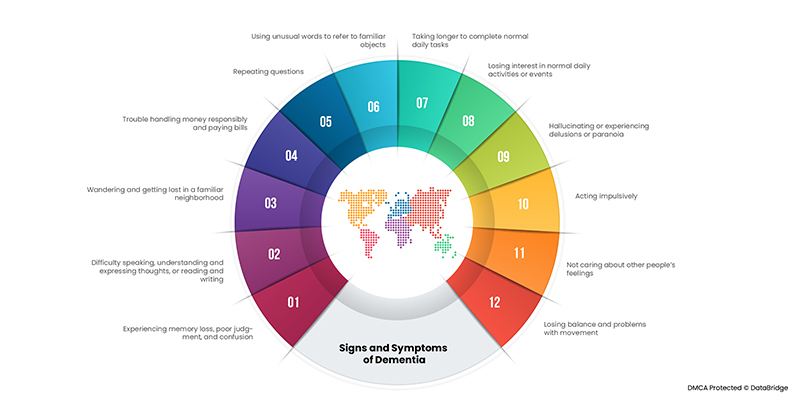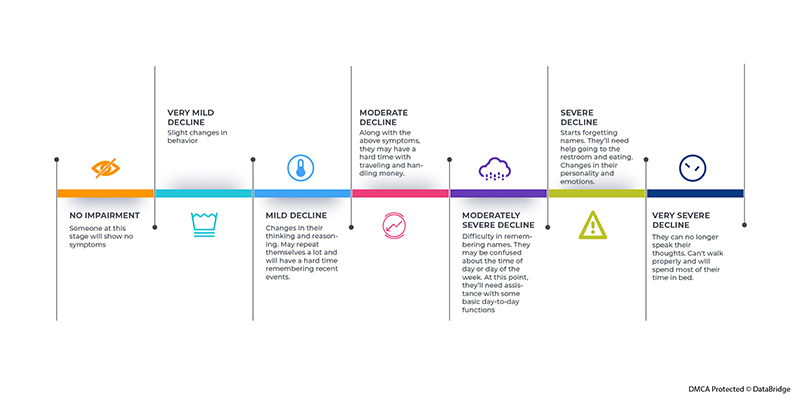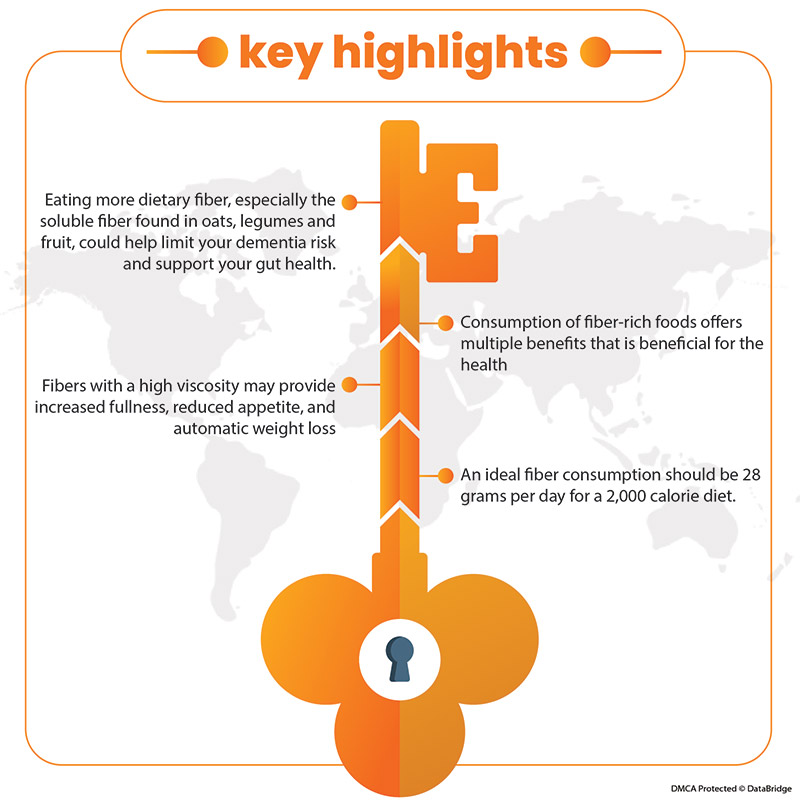What exactly is Dementia?
Dementia is a very sensitive disease that is more common as people grow older. Approximately one-third of all people aged 85 years or older may have some form of dementia. However, there are few cases wherein many people live into their 90s and beyond without any signs of dementia.
It is the loss of cognitive functioning which includes thinking, remembering, and reasoning and it effects to such an extent that it interferes with a person's day-to-day life. There are many people with dementia who cannot control their emotions, and as a result their personalities may change. It can range in terms of severity, starting from the mildest stage, when it just starts to affect the brain functioning slowly, to the most severe stage, when the person must depend completely on others for basic living activities.
Our DBMR team has investigated the global dementia - alzheimer disease market and witnessed that the market to account to grow at a CAGR of 10% in the above mentioned forecast period. The rise in prevalence of Alzheimer's across the globe is among the important factor expected to intensify the growth and demand of dementia - alzheimer disease market. North America region leads the dementia - Alzheimer disease market owing to the rise in awareness regarding Alzheimer's disease in the U.S. and the increase in the prevalence of Alzheimer's disease,
To know more about the study, please visit: https://www.databridgemarketresearch.com/reports/global-dementia-alzheimer-disease-market
Signs and Symptoms
There are varied signs and symptoms that are associated with dementia. People with dementia lose their healthy neurons, or nerve cells, as in they stop working. Although almost everyone loses some neurons with each passing age, but people with dementia experience far greater loss. Here is a list of varied signs and symptoms that are associated with dementia:

Causes of Dementia
Neurodegenerative disorders lead to progressive and irreversible loss of neurons and brain functioning. Alzheimer's disease is caused by the irregular buildup of two proteins called amyloid and tau. Deposits of amyloid, called plaques, build up around brain cells. Deposits of tau form "tangles" within brain cells. As brain cells become affected by Alzheimer's, chemical messengers also decrease, which is involved in sending messages, or signals, between brain cells.
The most common causes of dementia include:
Degenerative neurological diseases. These include:
- Parkinson's disease
- Huntington's disease
- Alzheimer's disease
- Few types of multiple sclerosis.
Our DBMR team has investigated global parkinson's disease market and witnessed that the prevalence of parkinson's disease among population across the globe acts as one of the major factors driving the growth of parkinson's disease market. North America dominates the Parkinson's disease market due to the increasing occurrence of the disorder and well-developed healthcare infrastructure. Asia-Pacific is expected to witness high growth during the forecast period of 2021-2028 due to the presence of untapped market and supportive government policies in the region.
To know more about the study, please visit: https://www.databridgemarketresearch.com/reports/global-parkinsons-disease-market
Vascular disorders which affect the blood circulation in your brain.
- Traumatic brain injuries
- Long-time alcohol or drug use
- Infections of the central nervous system, which include meningitis, HIV, and Creutzfeldt-Jakob disease
- Certain types of hydrocephalus, a buildup of fluid in the brain
Few of the reversible causes of dementia include:
- Alcohol or substance use disorder
- Subdural hematomas, blood clots beneath the outer covering of the brain
- Tumors
- Normal-pressure hydrocephalus
- Low levels of thyroid hormones, called hypothyroidism
- Low blood sugar, which is known as hypoglycemia
- Metabolic disorders such as a vitamin B12 deficiency
- HIV-associated neurocognitive disorders
Our DBMR team has investigated the global post-bariatric hypoglycemia (PBH) treatment market and witnessed that the increase in the prevalence of obesity globally is escalating the growth of post-bariatric hypoglycemia (PBH) treatment market. North America dominates the post-bariatric hypoglycemia (PBH) treatment market due to the high prevalence of obesity within the region. Asia-Pacific is expected to witness high growth during the forecast period of 2021 to 2028 because of the high population in the region.
To know more about the study, please visit: https://www.databridgemarketresearch.com/reports/global-post-bariatric-hypoglycemia-pbh-treatment-market
Stages of Dementia
There are varying stages of dementia that is explained below:

Prevalence of Dementia
The overall prevalent cases that include diagnosed and undiagnosed cases of dementia in both men and women are set to rise high over the next decade, reaching upto 12,000,000 by 2028. A recent Japanese study published in early February said that a diet high in fiber is related to a minimized risk of dementia later in life. If indulging oneself in a high-fiber diet becomes a standard recommendation to aid in preventing dementia, researchers expect that total incident cases of dementia could reduce among older adults in Japan.
Worldwide, approximately 55 million people have dementia, with over 60% living in low- and middle-income countries. With the increasing population of the elderly in nearly every country, this number is expected to rise to 78 million in 2030 and 139 million in 2050.
Importance of Fiber Diet in the Prevention of Dementia
Whole plant foods are good for the body's functionality, especially because of the fibers. Increasing evidence shows that adequate fiber intake may benefit digestion and reduce chronic disease risk. Fiber can be categorized into dietary, which can normally be defined as "nondigestible carbohydrates and lignin found in plants." Dietary fiber is further broken down into soluble and insoluble fiber. Another type is functional fiber which is extracted from natural foods or produced synthetically and only exists in isolation. Fiber is essential for the body; most of us fall short of the ideal quantity of fiber, consuming only about 9 to 11 grams daily. Many nutritionists recommend that women should consume 35 grams of fiber and that men should be 38 grams of fiber.
The latest FDA nutrition label recommends that the ideal fiber consumption should be 28 grams per day for a 2,000 calorie diet.
New research suggests another potential significant benefit. A high-fiber diet may trigger a chemical cascade that leads to reduced inflammation in the brain, implying age-related cognitive decline and memory loss, as well as a reduced risk of neurodegenerative diseases. Since this is a mouse study, it has the caveat that it "has not been tested in humans yet", but the results are significant when we first look at the fiber-to-brain connections. The researchers started by looking at a short-chain fatty acid called butyric acid, produced by bacteria ferment fiber in the gut. It has been shown to enhance memory in rodents.
To investigate whether a high-fiber diet produces similar effects to the butyrate dosage form, the researchers fed young and aged mice high-fiber and low-fiber diets, tested the butyrate's blood levels, and measured the intestinal level. The results showed that a high-fiber diet had comparable effects to drugs by increasing butyric acid and other short-chain fatty acids in both young and aged mice. found that it reduced intestinal inflammation in mice to levels indistinguishable from young mice. The researchers then genetically tested the mice and found that mice fed a high-fiber diet also had less inflammation in the brain's immune cells, known as microglia, which make up about 15% of all cells in the brain. Microglial inflammation is thought to be one of the main causes of age-related cognitive decline.
There are several benefits associated with fiber consumption:
- Digestion Becomes Smoother
Fiber-rich foods, including beans and legumes, whole grains, berries, and nuts, help in easing out the digestion process. It's been researched that soluble fiber combines with water to form a gel-like substance that creates bulk. A diet rich in high fiber will promote more regular digestion and less constipation.
- Acceleration of Zero Calories
With the consumption of double fiber intake from 12 to 24 grams per day, one can burn more calories, as per the recent research published in the American Journal of Clinical Nutrition. Our body cannot digest fiber but it attempts to burn calories in the process and boosts the metabolism. Approximately all that burnout would result in a 10-pound loss per year.
- Lowering of Cholesterol
Soluble fiber, specifically, has been associated with lower LDL cholesterol levels. Soluble fiber can be found in barley, oat bran, strawberries and apples. Fiber has absorbent properties, which helps bind the circulating cholesterol and then eliminate it from the body.
- Accelerates Energy
A high-fiber diet can be a great savior for an instant energy boost. Eating fiber and protein together balances blood glucose, providing the body with sustained energy throughout the day.
- For Glowing Skin
Fiber maintains toxins in the blood, thus eliminating them through the digestive tract instead of the pores, which can make your skin brighter and clearer. Fiber-rich fruits and vegetables are rich in antioxidants that might help to fight aging, such as artichokes, pears, and broccoli.
- Decreases Inflammation
Fiber is a prebiotic which plays a vital role in gut health and is essential for battling inflammation and lowering overall disease risk. As per the American Journal of Clinical Nutrition study, fiber works as a natural protective armor against C-reactive protein (CRP), which is a sign of acute inflammation.
- Reduces Bloating
Drinking at least three liters of water daily can avoid aches and unsettled stomach aches. It will lead to complete and regular bowel movements. One of the primary benefits of fiber is that it surges stool bulk, which eventually aids in preventing constipation and bloating, which is a great sign of relief from irritable bowel syndrome.
- Stabilization of blood sugar
Foods that are rich in fiber take longer to digest; hence blood sugar doesn't show dramatic fluctuation as it does with refined carbohydrates. Fiber slows down digestion and stabilizes blood sugar levels, curbing sugar cravings and sustaining energy. Balancing is a crucial thing with regard to the fiber consumption. For instance, when indulging in something lower-fiber, such as pancakes, if we balance out with a handful of sliced pears or a medium sliced banana, it will show a good result.
- Lowering of Hypertension
Improving the cholesterol levels and decreasing inflammation, fiber can really help in reducing heart disease risk and also lower down the blood pressure levels.
- Decreases Chances of Cancer
Fiber causes constant cell turnover, which is found to be beneficial in terms of digestion and colon health in preventing tumor growth. In addition, fiber helps reduce levels of circulating estrogen, which has been proven to reduce the risk of breast cancer.
DBMR 팀은 전 세계 대장암 치료 시장을 조사한 결과, 유전적 돌연변이 질환의 증가와 대장암 발병 위험을 높이는 건강에 해로운 생활 습관의 증가가 전 세계 대장암 치료 시장 성장을 촉진하는 것을 확인했습니다. 북미 지역은 의료 및 연구개발(R&D) 지출 증가, 그리고 신기술이나 기존 약물의 제형을 개발하는 글로벌 기업들의 적극적인 참여로 대장암 치료 시장 점유율을 주도하고 있습니다.
해당 연구에 대한 자세한 내용은 https://www.databridgemarketresearch.com/reports/global-colorectal-cancer-treatment-market에서 확인하세요.
고섬유질 식품 목록:
시중에는 다양한 고섬유질 식품이 판매되고 있지만, 일반 대중은 이에 대해 잘 알지 못합니다. 다음은 고섬유질 식품 몇 가지입니다.
- 배:
배는 맛있고 영양가가 높은 인기 과일이며, 섬유질의 가장 좋은 공급원 중 하나로 여겨집니다.
섬유질 함량: 100g당 5.5g 또는 3.1g
- 딸기
딸기는 신선하게 먹을 수 있는 맛있고 건강한 과일입니다. 비타민 C, 망간, 그리고 다양한 강력한 항산화제가 풍부하게 함유되어 있습니다.
섬유질 함량: 신선한 딸기 1컵에 3g, 100g당 2g
- 사과
사과는 섬유질이 비교적 풍부해서 많은 사람들이 좋아하는데, 특히 샐러드에 넣으면 더 좋습니다.
섬유질 함량: 100g당 4.4g 또는 2.4g
- 붉은 머리털
당근은 맛있고 아삭하며 영양가가 높아 많은 사람들이 좋아합니다. 비타민 K, 비타민 B6, 마그네슘, 그리고 체내에서 비타민 A로 전환되는 항산화제인 베타카로틴이 풍부합니다.
섬유질 함량: 생 당근 1컵에 3.6g, 100g당 2.8g
- 브로콜리
브로콜리는 비타민 C, 비타민 K, 엽산, 비타민 B, 칼륨, 철분, 망간이 풍부한 십자화과 채소로, 항산화제와 강력한 항암 영양소를 함유하고 있습니다. 다른 채소에 비해 단백질 함량도 비교적 높습니다.
섬유질 함량: 컵당 2.4g, 100g당 2.6g
- 렌즈콩
렌틸콩은 가장 영양가가 높고 흔한 식품 중 하나입니다. 단백질 함량이 매우 높고 여러 가지 중요한 영양소가 풍부하게 함유되어 있습니다.
섬유질 함량: 조리된 렌즈콩 1컵당 13.1g, 100g당 7.3g
- 콩과식물
대부분의 콩류는 단백질, 섬유질, 그리고 다양한 영양소가 풍부합니다. 제대로 조리하면 세계에서 가장 저렴한 양질의 영양소 공급원 중 하나입니다.
기타 고섬유질 콩류는 다음과 같습니다.
- 익힌 검은콩: 8.7그램
- 익힌 리마콩: 7그램
- 구운 콩: 5.5그램
- 익힌 에다마메: 5.2그램
- 귀리
귀리는 최근 알려진 가장 건강한 곡물 식품 중 하나입니다. 비타민, 미네랄, 항산화 성분이 매우 풍부합니다. 베타글루칸이라는 강력한 수용성 섬유질을 함유하고 있어 혈당과 콜레스테롤 수치에 큰 도움을 줍니다. 만들기도 매우 쉽고 직장인들 사이에서도 점점 더 흔해지고 있습니다.
섬유질 함량: 생오트밀 1컵당 16.5g, 100g당 10.1g
- 아몬드
아몬드는 건강에 좋은 지방, 비타민 E, 망간, 마그네슘 등 다양한 영양소를 함유한 인기 있는 견과류입니다 . 또한, 아몬드 가루를 첨가하여 베이킹에 사용할 수 있으며, 추가 영양소도 풍부합니다.
섬유질 함량: 3큰술당 4g, 100g당 13.3g.
- 다크 초콜릿
다크 초콜릿은 대다수의 사람들이 좋아하는 가장 맛있는 음식 중 하나입니다. 영양소가 풍부하고 항산화 및 영양소가 가장 풍부한 식품 중 하나입니다. 코코아 함량이 70~95% 이상인 다크 초콜릿을 선택하고 설탕이 많이 첨가된 제품은 피한다면 매우 유익할 것입니다.
섬유질 함량: 70~85% 카카오 1온스에는 3.1g, 100g당 10.9g이 함유되어 있습니다.
- 브뤼셀 콩나물
방울양배추는 브로콜리와 잘 어울립니다. 비타민 K, 칼륨, 엽산 함량이 매우 높고, 항암 효과가 있는 항산화제도 풍부합니다.
섬유질 함량: 컵당 3.3g 또는 100g당 3.7g.
- 아보카도
아보카도는 건강에 좋은 지방이 풍부한 과일입니다. 비타민 C, E, 칼륨, 마그네슘, 그리고 기타 비타민 B군 함량이 매우 높습니다. 또한 체중 감량, 면역력 강화 등 다양한 건강상의 이점을 제공합니다.
섬유질 함량: 1컵에 10g, 100g당 6.7g
식단에서 식이섬유 섭취를 늘리기 위한 몇 가지 팁
- 식단에 섬유질을 천천히 추가하세요
- 한 번에 너무 많은 섬유질을 섭취하면 경련, 복부 팽창 및 변비가 발생할 수 있습니다.
- 식단에 섬유질을 추가할 때 변비를 예방하기 위해 충분한 물(하루 최소 64온스 또는 8컵)을 마시도록 하십시오.
- 강화 밀가루가 아닌 통곡물을 첫 번째 성분으로 나열한 제품을 선택하십시오.
- 통곡물은 통곡물이지만 밀가루는 통곡물이 아닙니다.
- 빵 한 조각에 섬유질이 2~4g 함유된 통곡물 빵을 선택하세요.
- 1회 제공량당 최소 5g의 섬유질을 함유한 곡물을 선택하세요
- 주스 대신 생과일과 야채를 선택하고 껍질을 그대로 먹으세요.
- 통밀메밀, 통밀쿠스쿠스, 키노아, 불거, 밀 배아, 치아씨드, 대마씨드, 렌즈콩 파스타, 에다마메 파스타 등 대체 섬유질 옵션을 시도해 보세요.
- 팝콘은 통곡물이에요
- 더 건강한 간식을 원하시면 버터를 넣지 않은 저지방 간식을 드셔보세요. 브랜은 수프, 시리얼, 구운 식품, 스파게티 소스, 다진 소고기, 캐서롤 등에 뿌려 먹습니다.
- 밀기울은 오렌지 주스와도 잘 어울립니다.
- 건조 완두콩, 콩, 콩류를 밥이나 파스타 등의 메인 요리, 샐러드, 반찬에 넣어 드세요.
- 요거트, 시리얼, 밥, 머핀에 말린 과일을 첨가하세요
- 현미와 통밀 파스타를 먹어보세요
이러한 요인 외에도 섬유질 보충제를 섭취하는 것은 변비와 설사를 정상화하여 신체 기능에 도움을 줄 수 있는 또 다른 요인입니다. 자세한 내용은 다음과 같습니다.

수용성 섬유질은 불용성 섬유질에 비해 치매 예방에 특히 효과적이었습니다. 이러한 역상관관계는 수용성 섬유질 섭취와 더욱 두드러졌으며, 뇌졸중 병력이 없는 치매 환자에서만 나타났습니다. 채소나 과일과는 달리 감자는 고섬유질 식품과 유사한 연관성을 보였습니다. 일본 문화에서는 감자가 미국처럼 채소로 간주되지 않습니다. 이러한 이유로 연구진은 감자와 채소를 구분하기로 했습니다. 감자 전분 또한 채소와 매우 다릅니다. 수용성 섬유질이 풍부한 식품으로는 검은콩, 리마콩, 렌틸콩, 병아리콩, 에다마메, 보리, 아마씨, 치아씨드, 방울양배추, 고구마, 아보카도, 브로콜리, 비트, 배가 있습니다.
결론:
치매는 거의 대부분의 노인에게 영향을 미치는 매우 심각한 질병입니다. 이러한 환자를 위한 다양한 예방책이 있지만, 기본적인 치료 외에도 자연적인 방법들이 놀라운 효과를 보입니다. 섬유질이 풍부한 식단은 치매 예방에 도움이 됩니다. 미국이나 호주와 같은 많은 개발도상국에서는 사람들이 섬유질을 충분히 섭취하지 못하고 있습니다. 귀리, 콩류, 과일에 함유된 수용성 섬유질을 포함한 식이섬유를 더 많이 섭취하면 치매 위험을 줄이고 장 건강을 유지하는 데 도움이 될 수 있습니다. 섬유질이 풍부한 음식 섭취를 늘리려면 라즈베리, 사과, 바삭한 병아리콩과 같은 고섬유질 식품을 간식으로 섭취할 수 있습니다. 또한, 닭고기나 생선에 정제된 빵가루를 입히는 대신, 으깬 밀기울이나 귀리를 입혀 장 운동을 촉진하고 섬유질의 이점을 활용할 수 있습니다. 다음은 식단에서 섬유질을 늘리는 데 도움이 되는 몇 가지 예입니다.











